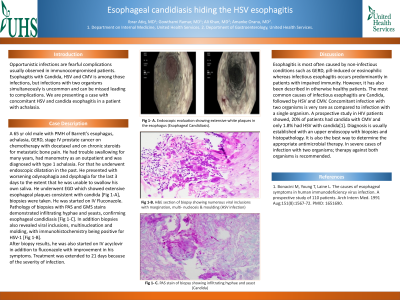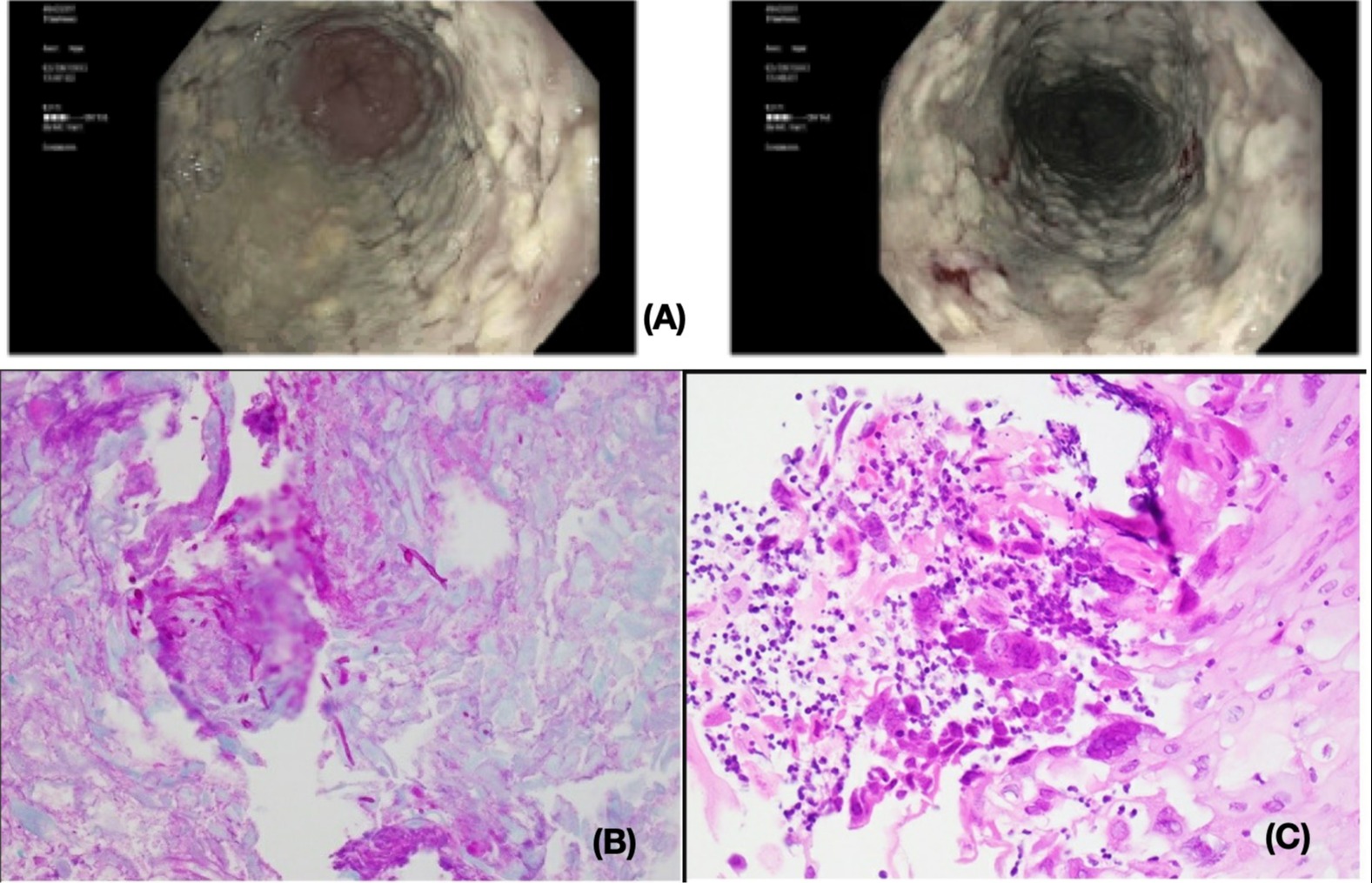Back


Poster Session B - Monday Morning
Category: Esophagus
B0235 - Esophageal Candidiasis Hiding the HSV Esophagitis
Monday, October 24, 2022
10:00 AM – 12:00 PM ET
Location: Crown Ballroom

Has Audio

Ibrar Atiq, MD
United Health Services- Wilson Hospital
Johnson City, NY
Presenting Author(s)
Ibrar Atiq, MD1, Gowthami Ramar, MD2, Ali Khan, MD2, Amanke Oranu, MD2
1United Health Services- Wilson Hospital, Johnson City, NY; 2United Health Services Hospital, Johnson City, NY
Introduction: Opportunistic infections are fearful complications usually observed in immunocompromised patients. Esophagitis with Candida, HSV and CMV is among those infections, but infections with two organisms simultaneously is uncommon and can be missed leading to complications. We are presenting a case with concomitant HSV and candida esophagitis in a patient with achalasia.
Case Description/Methods: A 65 yr old male with PMH of Barrett’s esophagus, achalasia, GERD, stage IV prostate cancer on chemotherapy with docetaxel and on chronic steroids for metastatic bone pain. He had trouble swallowing for many years, had manometry as an outpatient and was diagnosed with type 1 achalasia. For that he underwent endoscopic dilatation in the past. He presented with worsening odynophagia and dysphagia for the last 3 days to the extent that he was unable to swallow his own saliva. He underwent EGD which showed extensive esophageal plaques consistent with candida [Fig 1-A], biopsies were taken. He was started on IV Fluconazole.
Pathology of biopsies with PAS and GMS stains demonstrated infiltrating hyphae and yeasts, confirming esophageal candidiasis [Fig 1-B]. In addition biopsies also revealed viral inclusions, multinucleation and molding, with immunohistochemistry being positive for HSV-1 [Fig 1-C].
After biopsy results, he was also started on IV acyclovir in addition to fluconazole with improvement in his symptoms. Treatment was extended to 21 days because of the severity of infection.
Discussion: Esophagitis is most often caused by non-infectious conditions such as GERD, pill-induced or eosinophilic whereas infectious esophagitis occurs predominantly in patients with imparied immunity. However, it has also been described in otherwise healthy patients. The most common causes of infectious esophagitis are Candida, followed by HSV and CMV. Concomitant infection with two organisms is very rare as compared to infection with a single organism. A prospective study in HIV patients showed, 20% of patients had candida with CMV and only 1.8% had HSV with candida[1]. Diagnosis is usually established with an upper endoscopy with biopsies and histopathology. It is also the best way to determine the appropriate antimicrobial therapy. In severe cases of infection with two organisms; therapy against both organisms is recommended.

Disclosures:
Ibrar Atiq, MD1, Gowthami Ramar, MD2, Ali Khan, MD2, Amanke Oranu, MD2. B0235 - Esophageal Candidiasis Hiding the HSV Esophagitis, ACG 2022 Annual Scientific Meeting Abstracts. Charlotte, NC: American College of Gastroenterology.
1United Health Services- Wilson Hospital, Johnson City, NY; 2United Health Services Hospital, Johnson City, NY
Introduction: Opportunistic infections are fearful complications usually observed in immunocompromised patients. Esophagitis with Candida, HSV and CMV is among those infections, but infections with two organisms simultaneously is uncommon and can be missed leading to complications. We are presenting a case with concomitant HSV and candida esophagitis in a patient with achalasia.
Case Description/Methods: A 65 yr old male with PMH of Barrett’s esophagus, achalasia, GERD, stage IV prostate cancer on chemotherapy with docetaxel and on chronic steroids for metastatic bone pain. He had trouble swallowing for many years, had manometry as an outpatient and was diagnosed with type 1 achalasia. For that he underwent endoscopic dilatation in the past. He presented with worsening odynophagia and dysphagia for the last 3 days to the extent that he was unable to swallow his own saliva. He underwent EGD which showed extensive esophageal plaques consistent with candida [Fig 1-A], biopsies were taken. He was started on IV Fluconazole.
Pathology of biopsies with PAS and GMS stains demonstrated infiltrating hyphae and yeasts, confirming esophageal candidiasis [Fig 1-B]. In addition biopsies also revealed viral inclusions, multinucleation and molding, with immunohistochemistry being positive for HSV-1 [Fig 1-C].
After biopsy results, he was also started on IV acyclovir in addition to fluconazole with improvement in his symptoms. Treatment was extended to 21 days because of the severity of infection.
Discussion: Esophagitis is most often caused by non-infectious conditions such as GERD, pill-induced or eosinophilic whereas infectious esophagitis occurs predominantly in patients with imparied immunity. However, it has also been described in otherwise healthy patients. The most common causes of infectious esophagitis are Candida, followed by HSV and CMV. Concomitant infection with two organisms is very rare as compared to infection with a single organism. A prospective study in HIV patients showed, 20% of patients had candida with CMV and only 1.8% had HSV with candida[1]. Diagnosis is usually established with an upper endoscopy with biopsies and histopathology. It is also the best way to determine the appropriate antimicrobial therapy. In severe cases of infection with two organisms; therapy against both organisms is recommended.
Bonacini M, Young T, Laine L. The causes of esophageal symptoms in human immunodeficiency virus infection. A prospective study of 110 patients. Arch Intern Med. 1991 Aug;151(8):1567-72. PMID: 1651690.

Figure: Fig-1(A, Endoscopic evaluation) (B, PAS stain showing infiltrating hyphae and yeast )
(C, H&E section showing numerous viral inclusions with margination, multinucleosis and moulding)
(C, H&E section showing numerous viral inclusions with margination, multinucleosis and moulding)
Disclosures:
Ibrar Atiq indicated no relevant financial relationships.
Gowthami Ramar indicated no relevant financial relationships.
Ali Khan indicated no relevant financial relationships.
Amanke Oranu indicated no relevant financial relationships.
Ibrar Atiq, MD1, Gowthami Ramar, MD2, Ali Khan, MD2, Amanke Oranu, MD2. B0235 - Esophageal Candidiasis Hiding the HSV Esophagitis, ACG 2022 Annual Scientific Meeting Abstracts. Charlotte, NC: American College of Gastroenterology.

